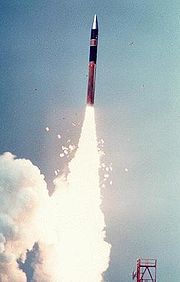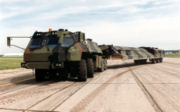Small Intercontinental Ballistic Missile
- Small Intercontinental Ballistic Missile
-

Midgetman Erprobungsflug

Gepanzertes Startfahrzeug für die Midgetman-Rakete
Die MGM-134 Midgetman, auch als SICBM (Small Intercontinental Ballistic Missile) bezeichnet, war eine für mobilen Einsatz ausgelegte Interkontinentalrakete der US-Streitkräfte.
Die Midgetman wurde aus dem Mitte der 1980er Jahre von der US Air Force formulierten Bedürfnis für eine kleine Interkontinentalrakete, die mobil auf straßengängigen Fahrzeugen stationiert werden könnte, entwickelt. Da Raketensilos durch einen von U-Booten gestarteten Erstschlag verwundbar sind, sah die militärische Führung der USA die Fähigkeit zu einem Vergeltungsschlag gefährdet. Diese Fähigkeit sollte durch die mobile Stationierung wiederhergestellt werden. Da die Sowjetunion mit der RT-23 Molodets (SS-24) und der RT-2PM Topol (SS-25) ebenfalls mobile Systeme entwickelte, zogen die USA mit der Midgetman nach.
System-Definitions-Studien für die SICBM (Small Intercontinental Ballistic Missile) wurden ab 1984 durchgeführt und Martin Marietta wurde 1986 autorisiert, die XMGM-134A Midgetman Rakete zu entwickeln. Der erste Prototyp wurde 1989 auf der Vandenberg Air Force Base gestartet, doch der Test erwies sich als Fehlschlag. Ein zweiter Testflug 1991 war erfolgreich.
Die XMGM-134A war als dreistufige Feststoffrakete konzipiert. Wie die größere LGM-118 Peacekeeper wurde sie auch mittels eines Kaltstartsystems gestartet, bei dem die Rakete mittels Gasdruck aus ihrer Startröhre katapultiert wurde und erst in einigen Metern Höhe außerhalb des Startgeräts gezündet wurde.
Die Midgetman-Rakete sollte in einem gepanzerten Startfahrzeug, dem sogenannten Hard Mobile Launcher (HML), stationiert werden. Diese Fahrzeuge sollten im Normalfall in einer Basis verbleiben und nur bei drohendem Kriegsausbruch bei internationalen Krisen mobil eingesetzt werden, um im Falle eines gegnerischen Erstschlags weniger gefährdet zu sein.
Die Midgetman hatte eine Reichweite von etwa 11.000 Kilometern. Der Sprengkopf bestand aus einem einzelnen Mk. 21 Wiedereintrittskörper mit einer thermonuklearen Bombe von 475 Kilotonnen Sprengkraft vom Typ W87-1. Das Trägheitsnavigationssystem gab der Midgetman eine Zielgenauigkeit (CEP) von 90 m.
Mit dem Ende des Kalten Kriegs reduzierten die USA ihre Neuentwicklungen von nuklearen Waffen und stellten daher das Programm im Januar 1992 ein.
Technische Daten
- Länge : 14 m
- Durchmesser : 1,17 m
- Gewicht : 13.600 kg
- Reichweite : 11.000 km
- Antrieb : dreistufige Feststoffrakete
- Sprengkopf : W-87-1 thermonuklear (475 Kilotonnen) in Avco Mark 21 Wiedereintrittskörper
Siehe auch
Weblinks
Wikimedia Foundation.
Schlagen Sie auch in anderen Wörterbüchern nach:
intercontinental ballistic missile — ballistic missile �al*lis tic mis sile, n. A rocket propelled missile of long range which is guided only during the powered portion of its flight, which usually takes only a small part of the total flight time; contrasted with {guided missile}.… … The Collaborative International Dictionary of English
ballistic missile — �al*lis tic mis sile, n. A rocket propelled missile of long range which is guided only during the powered portion of its flight, which usually takes only a small part of the total flight time; contrasted with {guided missile}. Note: Ballistic… … The Collaborative International Dictionary of English
intermediate range ballistic missile — ballistic missile �al*lis tic mis sile, n. A rocket propelled missile of long range which is guided only during the powered portion of its flight, which usually takes only a small part of the total flight time; contrasted with {guided missile}.… … The Collaborative International Dictionary of English
Intermediate-range ballistic missile — An intermediate range ballistic missile (IRBM) is a ballistic missile with a range of 3,000 5,500 km (1,865 3,420 miles), between a medium range ballistic missile and an intercontinental ballistic missile. Classifying ballistic missiles by range… … Wikipedia
Anti-ballistic missile — An anti ballistic missile (ABM) is a missile designed to counter ballistic missiles (a missile for missile defense). A ballistic missile is used to deliver nuclear, chemical, biological or conventional warheads in a ballistic flight trajectory.… … Wikipedia
Anti-Ballistic Missile Treaty — ▪ international treaty in full Treaty on the Limitation of Anti Ballistic Missile Systems arms control treaty ratified in 1972 between the United States and the Soviet Union (Union of Soviet Socialist Republics) to limit deployment of… … Universalium
missile — /mis euhl/ or, esp. Brit., / uyl/, n. 1. an object or weapon for throwing, hurling, or shooting, as a stone, bullet, or arrow. 2. See guided missile. 3. See ballistic missile. adj. 4. capable of being thrown, hurled, or shot, as from the hand or… … Universalium
Missile — For other uses, see Missile (disambiguation). A V 2 missile launch by the British during Operation Backfire. Though a missile may be any thrown or launched object, it colloquially almost always refers to a self propelled guided weapon system.… … Wikipedia
Ballistic coefficient — The ballistic coefficient (BC) of a body is a measure of its ability to overcome air resistance in flight. It is inversely proportional to the deceleration mdash;a high number indicates a low deceleration. BC is a function of mass, diameter, and… … Wikipedia
Missile launch control center — A guide (right) conducts a tour of the Launch Control Center at the Titan Missile Museum … Wikipedia


